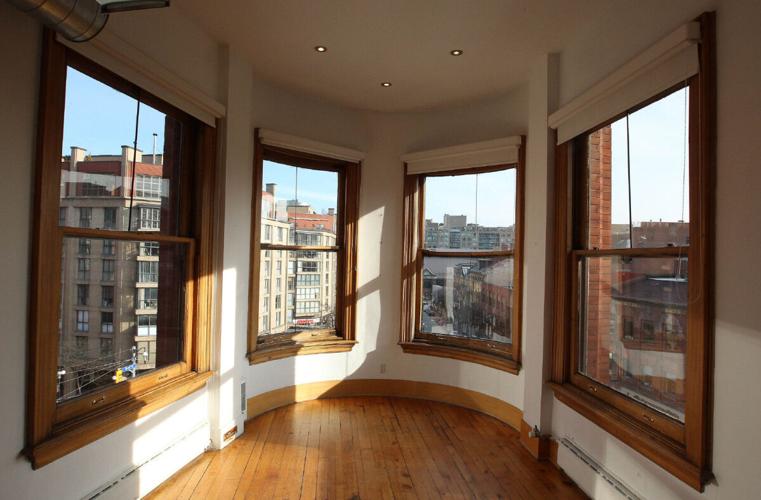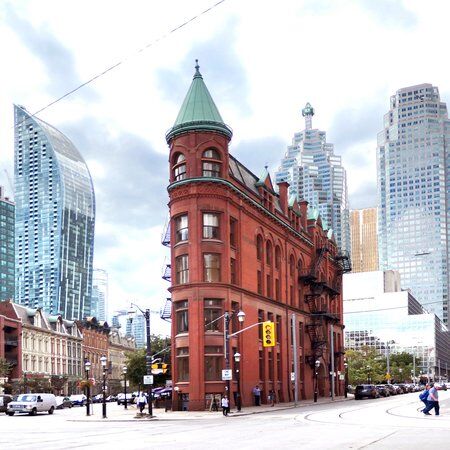Find Your Way: Navigate Parking Spots and Plan Your Trip.
Find Your Way: Navigate Parking Spots and Plan Your Trip.
Blog Article
Explore the Historical Relevance of the Gooderham Structure Situated in Toronto
The Gooderham Building, completed in 1892, embodies a rich tapestry of Toronto's building and commercial history, developed by the noteworthy David Roberts Jr. As it stands today, the Gooderham Building proceeds to play a vital role in the city's cultural landscape, motivating a better examination of its continuous impact on both the local economic situation and neighborhood identification.
Architectural Layout and Design
Although the Gooderham Structure, typically described as the Flatiron Building due to its distinctive form, showcases an interesting blend of building designs, it is primarily identified by its Romanesque Resurgence design. This building selection reflects the impact of 19th-century patterns, emphasizing durable forms and detailed outlining. The building's three-dimensional facade attributes rounded arcs, heavy stonework, and ornamental brick patterns, which with each other create a feeling of monumentality and permanence.
The framework's one-of-a-kind triangular account, which results from its area at the junction of Front and Wellington Streets, additionally enhances its building importance. The sharp angles and plunging rooflines contribute to a vibrant silhouette that stands out against Toronto's sky line. Furthermore, making use of terra cotta and red block products adds heat and texture to the structure, welcoming closer examination and gratitude of its workmanship.
Furthermore, the Gooderham Building's decoration, including cornices and gargoyle-like figures, exhibits the artistic flourishes regular of the Romanesque style. This interest to information not only boosts aesthetic charm yet additionally serves to communicate the structure's historic and cultural significance, solidifying its status as a valued building landmark in Toronto.

Historic History and Building And Construction
The Gooderham Structure's building relevance is deeply rooted in its historical context and construction. Finished in 1892, this famous structure was initially created as a distillery storehouse for the Gooderham and Worts Distillery, one of the biggest distilleries in the globe at the time. The building was developed throughout a period of quick industrial development in Toronto, mirroring the city's blossoming economic landscape.
Created utilizing neighborhood brick and featuring a distinct flatiron shape, the Gooderham Structure stands at the junction of Front and Wellington Streets, exhibiting the innovative spirit of late 19th-century style. The style, credited to designer David Roberts Jr., incorporates aspects of Romanesque and Gothic styles, showcasing complex describing and a famous turret that further boosts its silhouette.
The structure's construction was noted by the use sophisticated design methods for the period, enabling it to rise to six tales while accommodating the useful needs of the distillery. Gradually, the Gooderham Structure transitioned from industrial usage to industrial and retail rooms, yet it remains a crucial component of Toronto's architectural heritage, representing the city's historic evolution and resilience.

Financial Effect on the Area
Considering that its completion, the Gooderham Building has actually dramatically influenced the neighborhood economic climate, working as a catalyst for growth and growth in the bordering location (Gooderham Building address). Its famous design and calculated place in the heart of Toronto have brought in various companies and professionals, promoting an atmosphere ripe for entrepreneurship and investment
The structure's distinct design and historic importance have actually made it a focal factor for tourism, attracting visitors from all over the world. This increase of travelers has boosted regional businesses, consisting of restaurants, stores, and cultural venues, thus boosting the general economic vitality of the area. Additionally, the visibility of the Gooderham Building has actually brought about boosted building values in the location, contributing to local revenue with property tax obligations.

Cultural Value and Events
Beyond its financial payments, the Gooderham Structure holds significant cultural significance in Toronto's landscape. As a remarkable architectural gem, it embodies the Victorian Romanesque style, showing the city's historical advancement. The building's renowned flatiron shape adds to its condition as a precious icon of Toronto, bring in both locals and tourists alike.
The Gooderham Structure offers as a lively background for various social events and creative tasks (Gooderham Building address). It regularly hosts art exhibitions and community gatherings, fostering a sense of connection among residents. Additionally, its existence improves the character of the St. Lawrence Market area, known for its rich history and vibrant community life
Movie and digital photography fanatics often seek the Gooderham Building for its picturesque looks, making it a preferred topic in different media. Directed walking tours regularly highlight the structure's interesting stories, connecting it to Toronto's more comprehensive historic story.
Furthermore, the Gooderham Building plays an essential role in commemorating regional culture, with neighboring occasions such as the Toronto International Film Celebration and the Doors Open Toronto effort frequently featuring it as a vital site of interest (Gooderham Building address). Its long-lasting tradition underscores the relevance of protecting cultural spots within an advancing urban setting
Preservation and Remediation Initiatives
Among Toronto's dynamic city landscape, preservation and remediation initiatives for the Gooderham Building have actually ended up being vital in maintaining its building integrity and historic importance. Built in 1892, this iconic structure mirrors the distinct Flatiron design, characterized by its one-of-a-kind triangular shape and classy brickwork. Ongoing initiatives aim to navigate here guard its original functions while adapting to modern needs.
The conservation process includes thorough analyses to make sure any fixings or restorations recognize the building's historical context. Strategies such as using period-appropriate materials and competent craftsmanship are utilized to preserve the authenticity of the frontage. In addition, collaboration with heritage preservation experts has actually been pivotal in establishing techniques that straighten with municipal guidelines.
In the last few years, the Gooderham Building has undertaken remediation to enhance its structural security while protecting its visual beauty. The facility of a preservation strategy makes certain that future changes will certainly value the structure's personality, advertising lasting usage that honors its past.
These initiatives not only secure a crucial item of Toronto's building heritage however likewise foster area involvement by urging public appreciation of this historical landmark. Ultimately, the Gooderham Structure stands as a testimony to the city's dedication to maintaining its abundant history for future generations.
Final Thought
The Gooderham Structure exemplifies significant building and historical value within Toronto's landscape. As a vivid industrial space and social hub, the Gooderham Structure continues to play an essential function in Toronto's area and tourism.
Please visit one of our local supporters - Gamerama And The Repair Store - Iphone Repair Near Me
Report this page